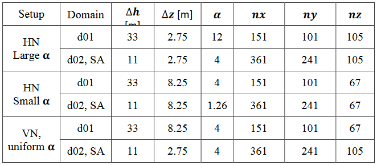Assessment of Vertical Mesh Refinement in Concurrently Nested Large-Eddy Simulations Using the Weather Research and Forecasting Model
- Lawrence Livermore National Laboratory, Livermore, California
To facilitate multiscale simulation using the Weather Research and Forecasting Model, vertical mesh refinement for one-way concurrent nested simulation was recently introduced. Grid refinement in the vertical dimension removes the requirement of different grid aspect ratios on the bounding versus the nested domain, such that results from refinement are in the horizontal directions only, and thereby can also reduce numerical errors on the bounding domain arising from large aspect ratios in the presence of complex terrain. Herein, the impacts of vertical grid refinement on the evolving downstream flow in nested large-eddy simulations are evaluated in relation to other model configuration choices, including turbulence subfilter-scale (SFS) stress models, mesh configuration, and alternative methods for calculating several near-surface flow parameters. Although vertical nesting requires coarsening of the vertical grid on the bounding domain, leading to a smaller range of resolved turbulence scales in the nest’s lateral boundary conditions, parameter values within the nested domains are generally only minimally impacted, relative to nesting using the same vertical grid on each domain. Two dynamic SFS models examined herein generally improved the simulated mean wind speed, turbulence kinetic energy, stresses and spectra, on both domains, and accelerated equilibration rates within nested domains, relative to two constant coefficient models. A new method of extrapolating horizontal velocity components to near-surface locations at nested domain lateral boundaries, and a correction to the calculation of deformation elements near the surface, are each shown to slightly alter the mean parameter values, yet only minimally impact equilibration rates within the nested domain.
- Research Organization:
- Lawrence Livermore National Lab. (LLNL), Livermore, CA (United States)
- Sponsoring Organization:
- USDOE National Nuclear Security Administration (NNSA)
- Grant/Contract Number:
- AC52-07NA27344
- OSTI ID:
- 1580198
- Alternate ID(s):
- OSTI ID: 1488779
- Report Number(s):
- LLNL-JRNL-703119
- Journal Information:
- Monthly Weather Review, Journal Name: Monthly Weather Review Vol. 145 Journal Issue: 8; ISSN 0027-0644
- Publisher:
- American Meteorological SocietyCopyright Statement
- Country of Publication:
- United States
- Language:
- English
Web of Science
Crossing Multiple Gray Zones in the Transition from Mesoscale to Microscale Simulation over Complex Terrain
|
journal | May 2019 |
Similar Records
Nested mesoscale-to-LES modeling of the atmospheric boundary layer in the presence of under-resolved convective structures
Local Area Forcing of Urban-to Regional-Scale Atmospheric Dispersion: Exchanging Fluxes in A Multiscale Environment
















